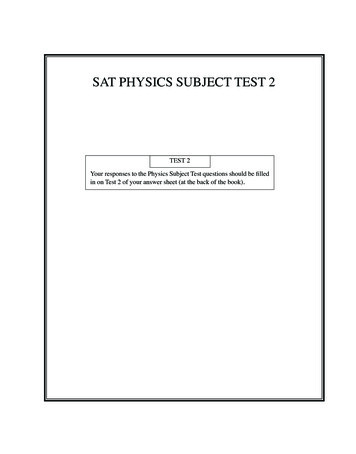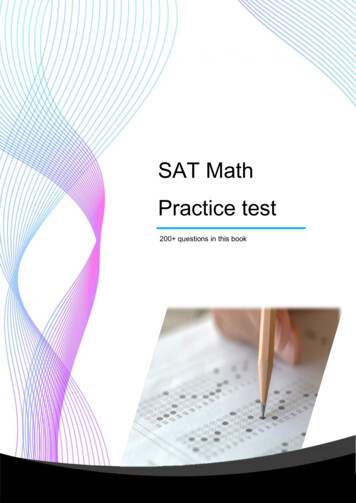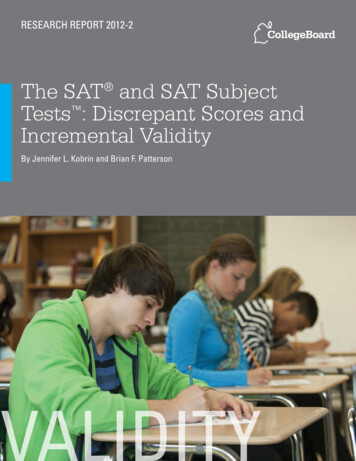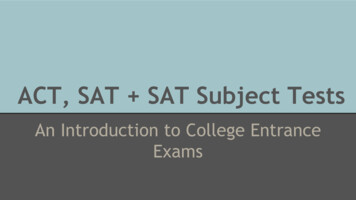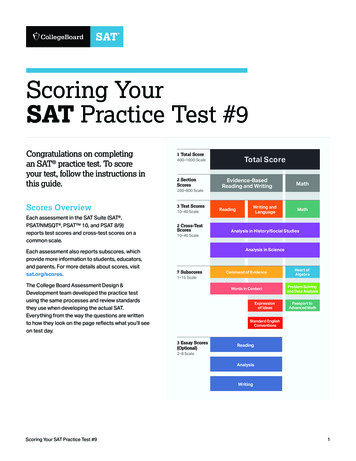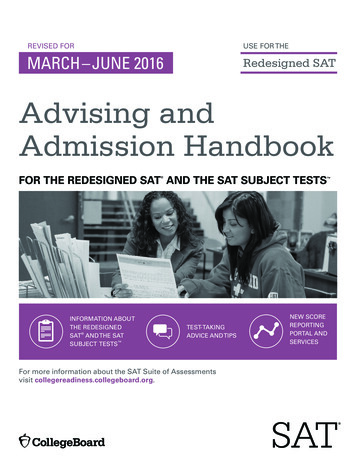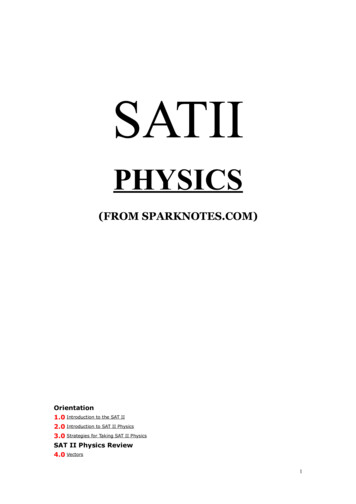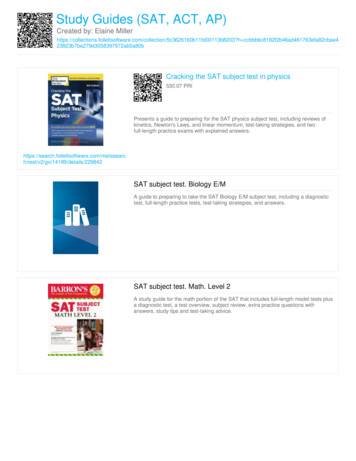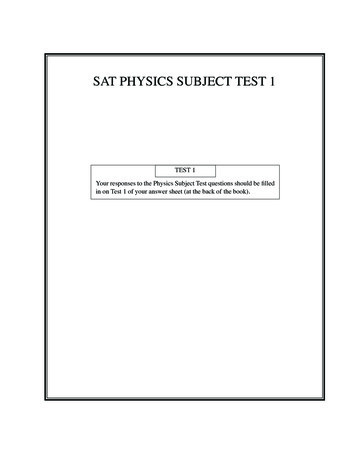
Transcription
SAT PHYSICS SUBJECT TEST 1TEST 1Your responses to the Physics Subject Test questions should be filledin on Test 1 of your answer sheet (at the back of the book).
PHYSICS SUBJECT TEST 175 Questions Time limit 1 hour Part AYou may NOT use a calculator.Directions: Each set of lettered choices below refers to the numbered questions immediately following it.Select the one letter choice that best answers each question or best fits each statement, and then fill in thecorresponding oval on the answer sheet. A choice may be used once, more than once, or not at all in each set.Questions 1-4For an object traveling in a straight line, its velocity(v, in m/s) as a function of time (t, in s) is given by thefollowing graph.vQuestions 1-4 relate to the following ear momentumKinetic energy6. If an object’s mass and the net force it feels areboth known, then Newton’s second law could beused to directly calculate which quantity?(D)t(A)(B)(C)(D)(E)5. Which one is NOT a vector?t(A)Questions 5-8t7. Which quantity can be expressed in the same unitsas impulse?8. If an object’s speed is changing, which of thequantities could remain constant?(C)t1. Which graph best depicts the object’s momentum?2. Which graph best illustrates the object’sacceleration?3. Which graph best depicts the object’s kineticenergy?4. Which graph best illustrates the object’s distancefrom its starting point?426 Cracking the SAT Physics Subject TestGO ON TO THE NEXT PAGE
PHYSICS SUBJECT TEST 1—ContinuedQuestions 9-10(A) Newton’s law of universal gravitation(B) Red shift of light from other galaxies(C) The fact that every element of atomicnumber greater than 83 is radioactive(D) The zeroth law of thermodynamics(E) Mass–energy equivalence9. Which provides the basis for the observation thatthe universe is expanding?10. Which principle could be used to help calculatethe amount of radiation emitted by a star?Questions onDiffractionInterference11. Which is due to the change in wave speed when awave strikes the boundary to another medium?12. Which phenomenon is NOT experienced bysound waves?GO ON TO THE NEXT PAGEThe Princeton Review Practice SAT Physics Subject Test 1 427
PHYSICS SUBJECT TEST 1—ContinuedPart BDirections: Each of the questions or incomplete statements below is followed by five suggested answers orcompletions. Select the one that is best in each case and then fill in the corresponding oval on the answer sheet.13. An astronaut standing on the surface of the moon(mass M, radius R) holds a feather(mass m) in one hand and a hammer(mass 100m) in the other hand, both at the sameheight above the surface. If he releases themsimultaneously, what is the acceleration of thehammer?(A)(B)(C)(D)(E)(A)(B)(C)(D)(E)m4 kgm6 m/sjust aftercollisionE12 kg-m/s16 kg-m/s18 kg-m/s24 kg-m/s32 kg-m/s16. If the collision were elastic, what is the totalkinetic energy of the blocks just AFTER thecollision?2rr14. Two satellites orbit the earth. Their orbits arecircular, and each satellite travels at a constantspeed. If the mass of Satellite #2 is twice themass of Satellite #1, which satellite’s speed isgreater? 4 kg15. What is the total momentum of the blocks justAFTER the collision?Satellite #1428v8 m/sjust beforecollisionmv 2rGMR2GMmR2GM100 2RGMm100 2RSatellite #2(A)(B)(C)(D)(E)Questions 15-17 refer to the collision of two blocks ona frictionless table. Before the collision, the block ofmass m is at rest.Satellite #1, by a factor of 2Satellite #1, by a factor of 2Satellite #2, by a factor of 2Satellite #2, by a factor of 2Neither; the satellites’ speeds are the same.Cracking the SAT Physics Subject Test(A)(B)(C)(D)(E)16 J32 J64 J128 J256 J17. If the blocks had instead stuck together after thecollision, with what speed would they move ifm 12 kg ?(A)(B)(C)(D)(E)2.0 m/s2.7 m/s3.2 m/s4.0 m/s4.6 m/sGO ON TO THE NEXT PAGE
PHYSICS SUBJECT TEST 1—Continued Q20. A simple harmonic oscillator has a frequency of2.5 Hz and an amplitude of 0.05 m. What is theperiod of the oscillations? qfixed inposition18. The figure above shows two positively chargedparticles. The Q charge is fixed in position, andthe q charge is brought close to Q and releasedfrom rest. Which of the following graphs bestdepicts the acceleration (a) of the q charge as afunction of its distance (r) from Q ?(A)(D)aarr(B)ar(C)21. A light wave, traveling at 3 108 m/s has afrequency of 6 1015 Hz. What is its wavelength?(A)(B)(C)(D)(E)5 10–8 m2 10–7 m5 10–7 m5 10–6 m2 107 m22. A beam of monochromatic light entering a glasswindow pane from the air will experience achange in(E)a(A) 0.4 sec(B) 0.2 sec(C) 8 sec(D) 20 sec(E) 50 secra(A)(B)(C)(D)(E)frequency and wavelengthfrequency and speedspeed and wavelengthspeed onlywavelength onlyr19. Two particles have unequal charges; one is q and the other is –2q. The strength of theelectrostatic force between these two stationaryparticles is equal to F. What happens to F if thedistance between the particles is halved?(A)(B)(C)(D)(E)It decreases by a factor of 4.It decreases by a factor of 2.It remains the same.It increases by a factor of 2.It increases by a factor of 4.GO ON TO THE NEXT PAGEThe Princeton Review Practice SAT Physics Subject Test 1 429
PHYSICS SUBJECT TEST 1—Continued24. If the cannonball projected from ground levelis in flight for a total time of T, what horizontaldistance does it travel?at timet 0v0m(A)1vT2 0(B) v0TH1m2θ1v2 0(C)(D)1v Tsinθ 02 01v Tcos θ 02 0(E) v0Tcos θ 0Questions 23-25Two cannons shoot cannonballs simultaneously. Thecannon embedded in the ground shoots a cannonballwhose mass is half that of the cannonball shot bythe elevated cannon. Also, the initial speed of thecannonball projected from ground level is half theinitial speed of the cannonball shot horizontally fromthe elevated position. Air resistance is negligible andcan be ignored. Each cannonball is in motion for morethan 2 seconds before striking the level ground.23. Let a1 denote the acceleration of the cannonballof mass m one second after launch, and let a2denote the acceleration of the cannonball ofmass m/2 one second after launch. Which of thefollowing statements is true?(A)(B)(C)(D)(E)a1 4a2a1 2a2a1 a2a2 2a1a2 4a125. For the cannonball of mass m, which of thefollowing quantities decreases as the cannonballfalls to the ground?(A)(B)(C)(D)(E)Kinetic energyPotential energyMomentumSpeedMass26. Which of the following statements is trueconcerning phase changes?(A) When a liquid freezes, it releases thermalenergy into its immediate environment.(B) When a solid melts, it releases thermalenergy into its immediate environment.(C) For most substances, the latent heat offusion is greater than the latent heat ofvaporization.(D) As a solid melts, its temperature increases.(E) As a liquid freezes, its temperaturedecreases.GO ON TO THE NEXT PAGE430 Cracking the SAT Physics Subject Test
PHYSICS SUBJECT TEST 1—Continued27. Four point charges are labeled Charge 1,Charge 2, Charge 3, and Charge 4. It is knownthat Charge 1 attracts Charge 2, Charge 2 repelsCharge 3, and Charge 3 attracts Charge 4. Whichof the following must be true?(A)(B)(C)(D)(E)Charge 1 attracts Charge 4.Charge 2 attracts Charge 3.Charge 1 repels Charge 3.Charge 2 repels Charge 4.Charge 1 repels Charge 4.bcdwhat constant timesV?R1201(B)10(C) 310(D) 109(E) 10330. If the power dissipated by resistor e is P, howmuch power is dissipated by resistor f ?(A)Questions 28-30a10 R, the3amount of current that passes through resistor a is29. If the total resistance in the circuit isefVAll six resistors in the circuit have the same resistance,R, and the battery is a source of constant voltage, V.28. How does the current through Resistor a comparewith the current through Resistor b ?(A) The current through Resistor a is 9 times thecurrent through Resistor b.(B) The current through Resistor a is 3 times thecurrent through Resistor b.(C) The current through Resistor a is the same asthe current through Resistor b.(D) The current through Resistor b is 3 times thecurrent through Resistor a.(E) The current through Resistor b is 9 times thecurrent through Resistor a.P(A) 6P(B)3P(C)2(D) P(E) 2P31. An object of mass 5 kg is acted upon by exactlyfour forces, each of magnitude 10 N. Whichof the following could NOT be the resultingacceleration of the object?(A)(B)(C)(D)(E)0 m/s22 m/s24 m/s28 m/s210 m/s2GO ON TO THE NEXT PAGEThe Princeton Review Practice SAT Physics Subject Test 1 431
PHYSICS SUBJECT TEST 1—Continued34. A rope stretched between two fixed points cansupport transverse standing waves. What is theratio of the sixth harmonic frequency to the thirdharmonic frequency?1(A)21(B)2(C) 232. The total force acting on an object as a functionof time is given in the graph above. What is themagnitude of the change in momentum of theobject between t 0 and t 0.4 sec?(A) 2 kg-m/sec(B) 5 kg-m/sec(C) 10 kg-m/sec(D) 12 kg-m/sec(E) 15 kg-m/sec33. An object is placed 20 cm from a diverging lens.If the distance between the lens and the image is8 cm, what is the magnification?1152(B)51(C)2(A)(D) 2 2(E) 435. In which of the following situations involving asource of sound and a detector of the sound is itpossible that there is NO perceived Doppler shift?(A) The source travels toward the stationarydetector.(B) The detector travels toward the stationarysource.(C) Both the source and the detector travel in thesame direction.(D) Both the source and detector travel inopposite directions, with the source anddetector moving away from each other.(E) Both the source and detector travel inopposite directions, with the source anddetector moving toward each other.(D) 2(E)52GO ON TO THE NEXT PAGE432 Cracking the SAT Physics Subject Test
PHYSICS SUBJECT TEST 1—Continued36. Sound waves travel at 350 m/s through warm airand at 3,500 m/s through brass. What happens tothe wavelength of a 700 Hz acoustic wave as itenters brass from warm air?(A)(B)(C)(D)(E)It decreases by a factor of 20.It decreases by a factor of 10.It increases by a factor of 10.It increases by a factor of 20.The wavelength remains unchanged when awave passes into a new medium.37. Which of the following types of electromagneticradiation has the longest wavelength?(A)(B)(C)(D)(E)Gamma raysUltravioletBlue lightX-raysOrange light38. The circular metal plate has a concentric circularhole. If the plate is heated uniformly, so that theouter circumference of the plate increases by 4percent, then the circumference of the hole will(A)(B)(C)(D)(E)decrease by 16 percentdecrease by 8 percentdecrease by 4 percentincrease by 4 percentincrease by 8 percent39. A box of mass 40 kg is pushed in a straight lineacross a horizontal floor by an 80 N force. If theforce of kinetic friction acting on the box has amagnitude of 60 N, what is the acceleration of thebox?(A)(B)(C)(D)(E)0.25 m/s20.5 m/s21.0 m/s22.0 m/s23.5 m/s2Trial 1:Trial 2:Trial 3:Trial 4:mass (in kg)0.5123speed (in m/s)432140. The table records the mass and speed of an objecttraveling at constant velocity on a frictionlesstrack, as performed by a student conducting aphysics lab exercise. In her analysis, the studenthad to state the trial in which the object hadthe greatest momentum and the trial in whichit had the greatest kinetic energy. Which of thefollowing gives the correct answer?(A)(B)(C)(D)(E)GreatestMomentumTrial 1Trial 2Trial 3Trial 3Trial 4GreatestKinetic EnergyTrial 3Trial 2Trial 2Trial 3Trial 4GO ON TO THE NEXT PAGEThe Princeton Review Practice SAT Physics Subject Test 1 433
PHYSICS SUBJECT TEST 1—Continued41. What did Rutherford’s experiments on alphaparticle scattering indicate about the structure ofthe atom?(A) Atoms are roughly spherical with a radius ofabout 10–10 m.(B) The electrons occupy quantized energylevels, absorbing or emitting energy onlywhen they make a quantum jump betweenthese levels.(C) The density of positive charge within anatom is not uniform throughout the atom’svolume.(D) Allowed electron orbits must havea circumference equal to a wholenumber times the electron’s de Brogliewavelength.(E) Alpha particles are positively charged.42. What happens to the pressure, P, of an ideal gas ifthe temperature is increased by a factor of 2 andthe volume is increased by a factor of 8 ?(A)(B)(C)(D)(E)P decreases by a factor of 16.P decreases by a factor of 4.P decreases by a factor of 2.P increases by a factor of 4.P increases by a factor of 16.43. How much current does a 60-watt lightbulb drawif it operates at a voltage of 120 volts?(A)(B)(C)(D)(E)0.25 amp0.5 amp2 amps4 amps30 amps21H 21 H 23 He X44. Identify the particle X resulting from the nuclearreaction shown Alpha particle45. If a 50 g block of solid marble (specific heat 0.9 kJ/kg· C), originally at 20 C, absorbs100 J of heat, which one of the following bestapproximates the temperature increase of themarble block?(A)(B)(C)(D)(E)1 C2 C4 C10 C20 C46. A sample of an ideal gas is heated, doubling itsabsolute temperature. Which of the followingstatements best describes the result of heating thegas?(A) The root-mean-square speed of the gasmolecules doubles.(B) The average kinetic energy of the gasmolecules increases by a factor of 2 .(C) The average kinetic energy of the gasmolecules increases by a factor of 4.(D) The speeds of the gas molecules cover awide range, but the root-mean-squarespeed increases by a factor of 2 .(E) The speeds of the gas molecules cover awide range, but the root-mean-squarespeed increases by a factor of 2.GO ON TO THE NEXT PAGE434 Cracking the SAT Physics Subject Test
PHYSICS SUBJECT TEST 1—Continued47. A block of ice, initially at –20 C, is heated at asteady rate until the temperature of the samplereaches 120 C. Which of the following graphsbest illustrates the temperature of the sample as afunction of time?Temp (ºC)(A)(B)1201000–20TimeTemp (ÀC)120Temp (ºC)(C)20Time120100–20(D)TimeTemp (ºC)120Temp (ºC)(E)0–20Time1201000–2048. Which of the following changes to a double-slitinterference experiment with light would increasethe widths of the fringes in the diffraction patternthat appears on the screen?(A)(B)(C)(D)(E)Use light of a shorter wavelengthMove the screen closer to the slitsMove the slits closer togetherUse light with a lower wave speedIncrease the intensity of the light49. In an experiment designed to study thephotoelectric effect, it is observed that lowintensity visible light of wavelength 550 nmproduced no photoelectrons. Which of thefollowing best describes what would occurif the intensity of this light were increaseddramatically?(A) Almost immediately, photoelectrons wouldbe produced with a kinetic energy equal tothe energy of the incident photons.(B) Almost immediately, photoelectrons wouldbe produced with a kinetic energy equal tothe energy of the incident photons minusthe work function of the metal.(C) After several seconds, necessary for theelectrons to absorb sufficient energy fromthe incident energy, photoelectrons wouldbe produced with a kinetic energy equal tothe energy of the incident photons.(D) After several seconds, necessary for theelectrons to absorb sufficient energy fromthe incident energy, photoelectrons wouldbe produced with a kinetic energy equal tothe energy of the incident photons minusthe work function of the metal.(E) Nothing would happen.TimeGO ON TO THE NEXT PAGEThe Princeton Review Practice SAT Physics Subject Test 1 435
PHYSICS SUBJECT TEST 1—Continued52. A nonconducting sphere is given a nonzero netelectric charge, Q, and then brought close toa neutral conducting sphere of the same radius.Which of the following will be true?E–21 eV–38 eV–85 eV–340 eVground state50. The diagram (not drawn to scale) gives the firstfew electron energy levels within a singleelectron atom. Which of the following gives theenergy of a photon that could NOT be emitted bythis atom during an electron transition?(A)(B)(C)(D)(E)17 eV42 eV64 eV255 eV302 eV53. Which of the following would increase thecapacitance of a parallel-plate capacitor? a1aaIa(A) An electric field will be induced within theconducting sphere.(B) The conducting sphere will develop a netelectric charge of –Q.(C) The spheres will experience an electrostaticattraction.(D) The spheres will experience an electrostaticrepulsion.(E) The spheres will experience no electrostaticinteraction.(A) Using smaller plates(B) Replacing the dielectric material betweenthe plates with one that has a smallerdielectric constant(C) Decreasing the voltage between the plates(D) Increasing the voltage between the plates(E) Moving the plates closer togetherA2 3 aaaB2ICaa 51. The figure above shows a pair of long, straightcurrent-carrying wires and four marked points.At which of these points is the net magnetic fieldzero?(A)(B)(C)(D)(E)436 D4Point 1 onlyPoints 1 and 2 onlyPoint 2 onlyPoints 3 and 4 onlyPoint 3 onlyCracking the SAT Physics Subject Test54. The four wires are each made of aluminum.Which wire will have the greatest resistance?(A)(B)(C)(D)(E)Wire AWire BWire CWire DAll the wires have the same resistance becausethey’re all composed of the same material.GO ON TO THE NEXT PAGE
PHYSICS SUBJECT TEST 1—ContinuedQuestions 55-5758. Lead-199 has a half-life of 1.5 hours. If aresearcher begins with 2 grams of lead-199, howmuch will remain after 6 hours?0.16 mDisplacementODistance0.60 m(A)(B)(C)(D)(E)0.125 grams0.25 grams0.375 grams0.5 grams0.625 grams55. What is the amplitude of the wave?(A)(B)(C)(D)(E)0.08 m0.16 m0.32 m0.48 m0.60 m56. What is the wavelength of the wave?(A)(B)(C)(D)(E)0.08 m0.16 m0.20 m0.40 m0.60 m57. The drawing shows the displacement of atraveling wave at time t 0. If the wave speed is0.5 m/sec, and the wavelength is λ m, what is theperiod of the wave (in seconds)?14λ1(B)2λ(C) 1λ(A)(D) 2λ(E) 4λGO ON TO THE NEXT PAGEThe Princeton Review Practice SAT Physics Subject Test 1 437
PHYSICS SUBJECT TEST 1—Continued59. The square shown is the same size in each ofthe following diagrams. In which diagram is theelectrical potential energy of the pair of chargesthe greatest?60. Four point charges, two positive and twonegative, are fixed in position at the corners of asquare, as shown below.Which one of the following arrows best illustratesthe total electrostatic force on the charge in thelower right-hand corner of the square?(A)(B)(C)(D)(E)The electric force on this charge is 0.GO ON TO THE NEXT PAGE438 Cracking the SAT Physics Subject Test
PHYSICS SUBJECT TEST 1—Continued50 cmtableOmfloor61. One end of a rigid, massless rod of length 50cm is attached to the edge of the table at pointO; at the other end of the rod is a ball of clay ofmass m 0.2 kg. The rod extends horizontallyfrom the end of the table. What is the torque ofthe gravitational force on the clay ball relative topoint O ?(A)(B)(C)(D)(E)63. The four forces act on the block as it moves thedistance L. What is the total work performed onthe block by these forces?(A)(B)(C)(D)(E)(F f)L(F f)L(N w)L(N w)L(F N f w)L0.01 N-m0.1 N-m1 N-m10 N-m100 N-m62. Two rocks are dropped simultaneously from thetop of a tall building. Rock 1 has mass M1, androck 2 has mass M2. If air resistance is negligible,what is the ratio of rock 1’s momentum to rock2’s momentum just before they hit the ground?M1M2M1(B)M2M1(C)M2(A)( )2(D) 1(E) None of the aboveGO ON TO THE NEXT PAGEThe Princeton Review Practice SAT Physics Subject Test 1 439
PHYSICS SUBJECT TEST 1—Continuedlightbulbinsulating handlevariableresistor64. A loop of metal wire containing a tiny lightbulb isattached to an insulating handle and placed over acoil of wire in which a current can be establishedby a source of emf and controlled by a variableresistor. The plane of the top loop is parallelto the plane of the bottom coil. Which of thefollowing could NOT cause the bulb to light?(A) Rotating the handle 90 while keeping theplane of the top loop parallel to the planeof the bottom coil(B) Raising the handle up and away from the coil(C) Lowering the handle down toward the coil(D) Decreasing the resistance of the coil(E) Increasing the resistance of the coil65. During each cycle, a heat engine with anefficiency of 25% takes in 800 J of energy. Howmuch waste heat is expelled during each cycle?(A)(B)(C)(D)(E)RR100 J200 J300 J400 J600 J Q Q–Q66. Three point charges are arranged along a straightline. If k denotes Coulomb’s constant, what isthe strength of the electrostatic force felt by thepositive charge at the left end of the line?kQ 2(A)2 R2kQ 2(B)R23kQ 2(C)4 R25kQ 2(D)4 R22(E) 3kQ2 R267. Consider two adjacent transparent media. Thespeed of light in Medium 1 is v1, and the speedof light in Medium 2 is v2. If v1 v2, then totalinternal reflection will occur at the interfacebetween these media if a beam of light is(A) incident in Medium 1 and strikes theinterface at an angle of incidence greaterthan sin–1(v1/v2).(B) incident in Medium 1 and strikes theinterface at an angle of incidence greaterthan sin–1(v2/v1).(C) incident in Medium 2 and strikes theinterface at an angle of incidence greaterthan sin–1(v1/v2).(D) incident in Medium 2 and strikes theinterface at an angle of incidence greaterthan sin–1(v2/v1).(E) Total internal reflection is impossible in thesituation described.GO ON TO THE NEXT PAGE440 Cracking the SAT Physics Subject Test
PHYSICS SUBJECT TEST 1—ContinuedQuestions 68-6970. A particle travels in a circular path of radius0.2 m with a constant kinetic energy of 4 J.What is the net force on this particle?kmXOY block is attached to the end of a linear spring, theAother end of which is anchored to a wall. The blockis oscillating between extreme positions X and Y on africtionless table, and when the block is at Point O, thespring is at its natural length. The value of the spring’sforce constant, k, is known, but the mass of the block,m, is unknown.68. Knowing which one of the following wouldpermit you to calculate the value of m ?(A) The acceleration of the block at Point O(B) The acceleration of the block at Point Y(C) The speed of the block as it passesthrough O(D) The distance between X and Y(E) The time required for the block to travelfrom X to Y69. If ω k, and the distance between O and Y ismd, what is the speed of the block at point O ?dω2(B) dω(A)(A)(B)(C)(D)(E)4N16 N20 N40 NCannot be determined from theinformation givenQuestions 71-72YZ4 cm3 cm Q3 cmX71. How much work is done by the electric fieldcreated by the stationary charge Q 2.0 C tomove a charge of 1.0 10–9 C from position Xto position Z ? (Note: The value of Coulomb’sconstant, k, is 9 109 N-m2/C2.)(A)0J(B) 150 J(C) 300 J(D) 560 J(E) 1,000 J(C) 2dω(D) d 2ω(E) dω 2GO ON TO THE NEXT PAGEThe Princeton Review Practice SAT Physics Subject Test 1 4 41
PHYSICS SUBJECT TEST 1—Continued72. If EY is the electric field strength at position Y andEZ is the electric field strength at position Z, whatEis the value of Z ?EY(A)(B)(C)(D)(E)(A) The impulse delivered to the catcher’s handis reduced due to the presence of the mitt.(B) The force on the catcher’s hand is reducedbecause of the increased area provided bythe mitt.(C) The baseball’s change in momentum isreduced due to the presence of the mitt.(D) The force on the catcher’s hand is reducedbecause the mitt increases the time ofimpact.(E) The force on the catcher’s hand is reducedbecause the mitt decreases the time ofimpact.34434391616973. An object is placed 100 cm from a plane mirror.How far is the image from the object?(A)(B)(C)(D)(E)74. Why do baseball catchers wear mitts ratherthan just using their bare hands to catch pitchedbaseballs?50 cm100 cm200 cm300 cm400 cm75. A spaceship is moving directly toward a planet atca speed of . When the spaceship is 4.5 108 m2from the planet (as measured by someone on thespaceship), a pulse of light is emitted by someoneon the planet. As measured by someone on thespaceship, how long does it take the light pulse totravel from the planet to the ship?(A)(B)(C)(D)(E)0.5 sec1.0 sec1.5 sec2.0 sec2.5 secSTOPIf you finish before time is called, you may check your work on this test only.Do not turn to any other test in this book.442 Cracking the SAT Physics Subject Test
PHYSICS SUBJECT TEST 1—Continued The Princeton Review Practice SAT Physics Subject Test 1 431 GO ON TO THE NEXT PAGE 27. 29.Four point charges are labeled Charge 1, Charge 2, Charge 3, and Charge 4. It is known that Charge 1 attracts Charge 2, Charge 2 repels Charge 3, and Charge 3 attracts Charge 4. Which of the following must be true?

